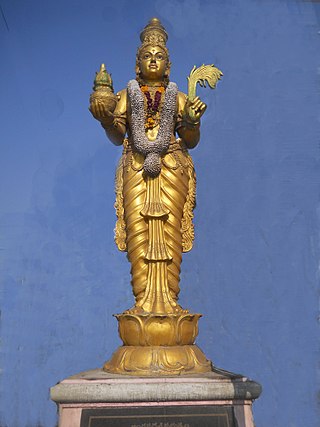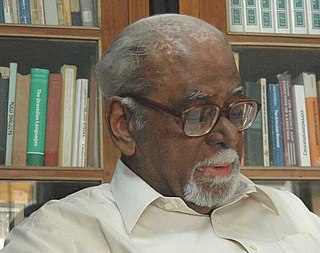Related Research Articles

The Dravidian languages are a family of languages spoken by 250 million people, mainly in southern India, north-east Sri Lanka, and south-west Pakistan. Dravidian is first attested in the 2nd century BCE, as inscriptions in Tamil-Brahmi script on cave walls in the Madurai and Tirunelveli districts of Tamil Nadu.

Telugu is a Dravidian language native to the Indian states of Andhra Pradesh and Telangana, where it is also the official language. Spoken by about 96 million people (2022), Telugu is the most widely spoken member of the Dravidian language family, and one of the twenty-two scheduled languages of the Republic of India. It is one of the few languages that has primary official status in more than one Indian state, alongside Hindi and Bengali. Telugu is one of the six languages designated as a classical language by the Government of India. It is the 14th most spoken native language in the world. Modern Standard Telugu is based on the dialect of erstwhile Krishna, Guntur, East and West Godavari districts of Coastal Andhra.

Tulu is a Dravidian language whose speakers are concentrated in Dakshina Kannada and in the southern part of Udupi of Karnataka in south-western India and also in the northern parts of the Kasaragod district of Kerala. The native speakers of Tulu are referred to as Tuluva or Tulu people and the geographical area is unofficially called Tulu Nadu.

Kasaragod is a municipal town and administrative headquarters of Kasaragod district in the state of Kerala, India. Established in 1966, Kasaragod was the first municipal town in the district. It is the northernmost district of Kerala and is also known as Sapta Bhasha Sangama Bhumi.
Pillai or Pillay, meaning "Child of King"(Prince), is a surname found among the Tamil and Malayalam-speaking people of India and Sri Lanka. Traditionally used by various Vellalar subcastes, upper caste Nairs, and some Brahmins, often bestowed by ruling royal families of Kerala and Tamil Nadu. It is also used by many Tamil-speaking castes, including Rowther, Isai Vellalar, Karaiyar, Agamudayar, etc and less commonly found among Malayalam-speaking communities like Nazrani Mappila and Marars of travancore.
South Indian culture refers to the cultural region typically covering the South Indian states of Tamil Nadu, Karnataka, Kerala, Andhra Pradesh, and Telangana. The idea of South India is closely linked to the Dravidian ethnic and linguistic identity and therefore it can also refer to groups in central India such as the Gondi and the Kui. Similar to India it is difficult to define a common essence of South Indian culture. That being some common threads include the eternal universe through the celebration of the beauty of the body and femininity. It is exemplified through its dance, clothing, and sculptures.

Robert Caldwell was a missionary for London Missionary Society. He arrived in British India at age 24, and studied the local language to spread the word of the Bible in a vernacular language, studies that led him to author a text on comparative grammar of the South Indian languages. In his book, Caldwell proposed that there are Dravidian words in the Hebrew of the Old Testament, the archaic Greek language, and the places named by Ptolemy.

Murray Barnson Emeneau was the founder of the Department of Linguistics at the University of California, Berkeley.

Telugu people, also called Telugus, are an ethno-linguistic group who speak the Telugu language and are native to the Indian states of Andhra Pradesh, Telangana and Yanam district of Puducherry. They are the most populous of the four major Dravidian groups. Telugu is the fourth most spoken language in India and the 14th most spoken native language in the world. A significant number of Telugus also reside in the Indian states of Karnataka, Tamil Nadu, Orissa, Maharashtra. Members of the Telugu diaspora are spread across countries like United States, Australia, Malaysia, Mauritius, UAE, and others. Telugu is the fastest-growing language in the United States. It is also a protected language in South Africa.

Since the Iron Age in India, the native languages of the Indian subcontinent are divided into various language families, of which the Indo-Aryan and the Dravidian are the most widely spoken. There are also many languages belonging to unrelated language families such as Munda and Tibeto-Burman, spoken by smaller groups.

John William Beames was a civil servant and author in British India. He served in the Punjab from March 1859 to late 1861, and in Bengal from December 1861 until the conclusion of his service in 1893. He was also a scholar of Indian history, literature and linguistics. His great work was a comparative grammar of Indo-Aryan languages, published in three volumes in 1872–1879. When he retired from the Indian Civil Service in March 1893, he had gained extensive knowledge of Indian life, and in 1896 wrote an account of his career, first published in 1961 as Memoirs of a Bengal Civilian.
Kota is a language of the Dravidian languages with about 900 native speakers in the Nilgiri hills of Tamil Nadu state, India. It is spoken mainly by the tribal Kota people (India). In the late 1800s, the native speaking population was about 1,100. In 1990, the population was only 930, out of an ethnic population of perhaps 1,400, despite the great increase in the population of the area. The language is 'critically endangered' due to the greater social status of neighbouring languages. The Kota language may have originated from Tamil-Kannada and is closely related to toda language. The Kota population is about 2500. The origin of the name Kota is derived from the Dravidian root word 'Ko' meaning Mountain.
Dravidian studies is the academic field devoted to the Dravidian languages, literature, and culture. It is a superset of Tamil studies and a subset of Indology.

Kamil Václav Zvelebil was a Czech scholar in Indian literature and linguistics, notably Tamil, Sanskrit, Dravidian linguistics and literature and philology.

Bhadriraju Krishnamurti was an Indian linguist, specialized in Dravidian languages. He was born in Ongole. He was Vice Chancellor of Hyderabad Central University from 1986 to 1993 and founded the Department of Linguistics at Osmania University where he served as professor from 1962 to 1986. His magnum opus The Dravidian Languages is considered a landmark volume in the study of Dravidian linguistics.
Francis Whyte Ellis (1777–1819) was a British civil servant in the Madras Presidency and a scholar of Tamil and Sanskrit.
Pandy Malayalam or Pandyan Malayalam is a dialect of Malayalam spoken by immigrants from Pandian kingdom in those regions of Kerala. It is the most spoken dialect in the district of Trivandrum and, according to an 1875 work by Robert Caldwell, this was also the case then in southern parts of Kollam district.
Malaysian Tamil, also known as Malaya Tamil, is a local variant of the Tamil language spoken in Malaysia. It is one of the languages of education in Malaysia, along with English, Malay and Mandarin. There are many differences in vocabulary between Malaysian Tamil and Indian Tamil.
The importance of Tamil loanwords in Biblical Hebrew is that linguistically these words are the earliest attestation of the Tamil language. These words were incorporated into the writing of the Hebrew Bible starting before 500 BCE. Although a number of authors have identified many biblical and post-biblical words of Tamil, Old Tamil, or Dravidian origin, a number of them have competing etymologies and some Tamil derivations are considered controversial.
Tamil loanwords in Ancient Greek came about due to the interactions of Mediterranean and South Indian merchants. Tamil loanwords entered the Greek language during different periods in history. Most words had to do with items of trade that were unique to South India. There is a general consensus about Tamil loanwords in Ancient Greek, while a few of the words have competing etymologies.
References
- ↑ Robert Caldwell (1856). A Comparative Grammar of the Dravidian Or South-Indian Family of Languages. Asian Educational Services (Reprint of 1913 3rd-edition revised by Reverend J.L. Wyatt and T Ramakrishna Pillai). pp. 88–105. ISBN 978-81-206-0117-8.